
We believe the future of Web3 lies in the hands of developers, the creative innovators who will leverage the unique composability features enabled by smart contract platforms to create novel, killer applications. In order for this to happen, we need to make it easier for developers and companies to build, deploy, manage, and upgrade on-chain programs. We refer to this new period of development as Web3’s “Age of Abstraction,” where companies create products that automate and abstract away back-end infrastructure, enabling developers to more easily build using smart contracts and Web3 native protocols.
Although it sounds academic in nature, the concept of abstraction is everywhere around us in various forms and functions. Abstraction is often driven by a combination of innovation and creativity, like when Frank McNamara invented the credit card and abstracted away the need to carry cash, or when Pablo Picasso created cubism by painting subjects in a purely abstracted form.
The history of computer science gives us countless examples of how technical abstraction has facilitated more development over time. Over the last half-century, we’ve gone from binary and machine-level languages to high-level machine-independent languages like JavaScript and Python. In 2002, Amazon launched AWS to “enable developers to build innovative and entrepreneurial applications on their own,” unleashing two decades of server virtualization and migration into the cloud.
We believe the same evolution of abstraction will materialize in Web3, making the low-level protocol stack more accessible to the global developer community so they can build innovative and entrepreneurial applications on their own. Abstractions in Web3 will open development to a broader audience by:
- Making it easier to launch products/apps on-chain
- Making it cheaper to build and maintain products/apps on-chain
Our first investment in this thesis area was Blockdaemon, an enterprise-grade node management platform that allows anyone to spin up blockchain nodes in minutes. Blockdaemon’s platform virtualizes blockchain nodes so developers don’t have to set up, deploy, and manage physical hardware and run the software client.
Blockdaemon has been a massive driver of on-chain development and adoption amongst large enterprises, with fifty-five thousand nodes currently live across more than sixty Web3 protocols. In simple terms, Blockdaemon reduces the friction and cost of launching blockchain nodes, making direct network participation a far more approachable concept for large enterprises that don’t have the specialized developer talent necessary.
The Wars To Come
The so-called “Smart Contract Wars” have been raging on for almost half a decade. Although they’re far from over, we believe a few (2-4) smart contract platforms will separate from the pack and dominate market share in the next five years. This will be driven by the physics of scaling adoption of technical platforms, similar to what we’ve witnessed previously with computer and mobile operating systems. For smart contract platforms, this is what the flywheel looks like:
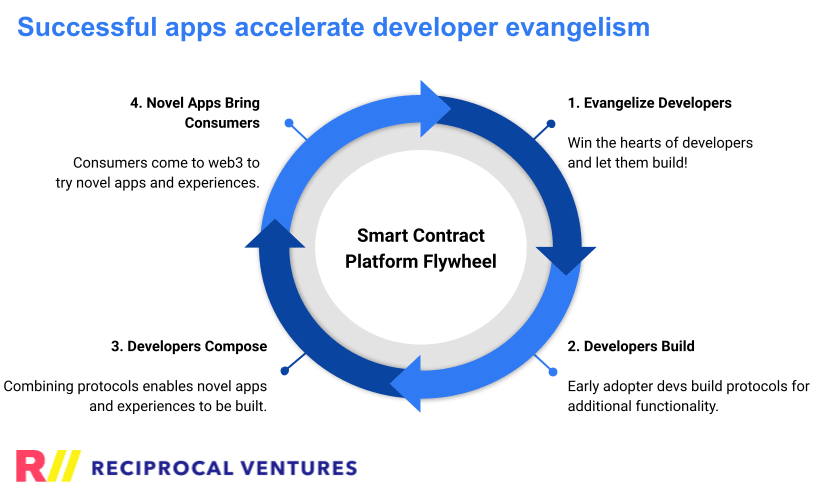
The journey to one billion users in Web3 starts with getting the first million developers building in the space. In order to accomplish this, the leading ecosystems will require infrastructure abstractions that are specialized to their specific hardware, consensus mechanisms, programming languages, development libraries, and frameworks, as well as the top use cases.
We’ve been active in the Solana ecosystem since our initial seed investment in Solana Labs in 2018, and over the last year have noticed an increasing demand for more specialized high-performance infrastructure. The earliest adopters of new technology will build despite a lack of infrastructure or tooling, commonly referred to as “eating glass” in the Solana ecosystem. But glass eating will be a tough sell if we want to cross the chasm and usher in the early majority of developers, which is the next step towards mass adoption.
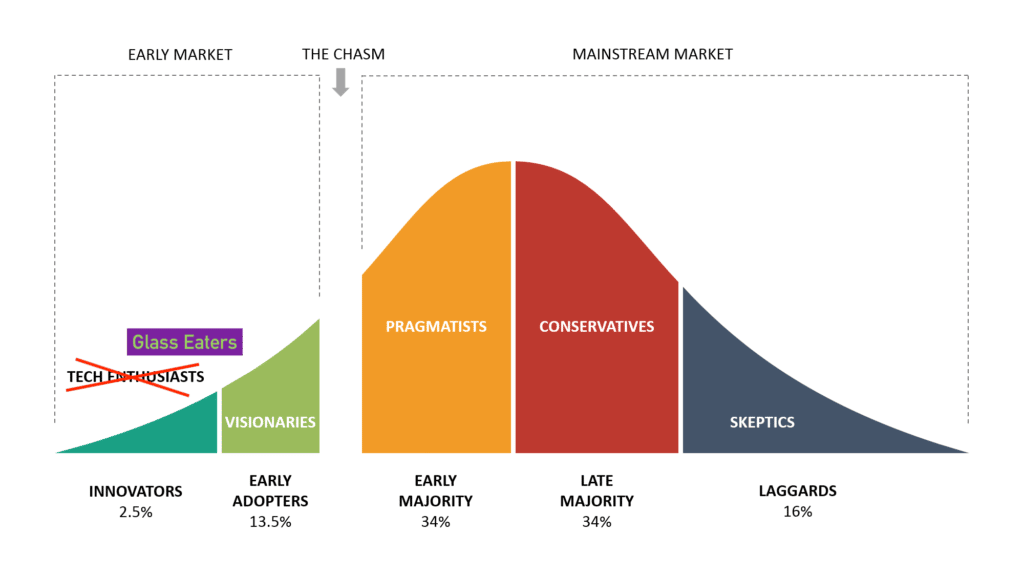
The Future of Solana Infrastructure
We recently announced our investment in Helius, a blockchain infrastructure platform specifically designed to optimize the building experience on Solana. Helius offers specialized APIs and back-end infrastructure that enable builders to harness the power of the Solana blockchain without having to build, operate, or manage the infrastructure themselves.
If you want to build an application on Solana today, you have to:
- Set up your own RPC nodes.
- Set up internal infrastructure for indexing and storage.
- Set up pipelines for processing the data.
- Set up parsers & interpreters to parse each smart contract of interest. This becomes very difficult if the protocol is closed-source or hasn’t released its IDL.
- Call other APIs (such as USD rates, NFT metadata, etc) for enrichment.
- Continuously maintain and pay infrastructure costs for all of the above. New contracts, standards, and protocols are added daily, which you’ll have to keep up with.
The Helius platform handles all this tedious and resource-intensive work so you don’t have to, cutting time to launch from months to minutes. We classify Helius’ products into three primary categories: RPC servers, Enhanced Data APIs, and Webhooks.
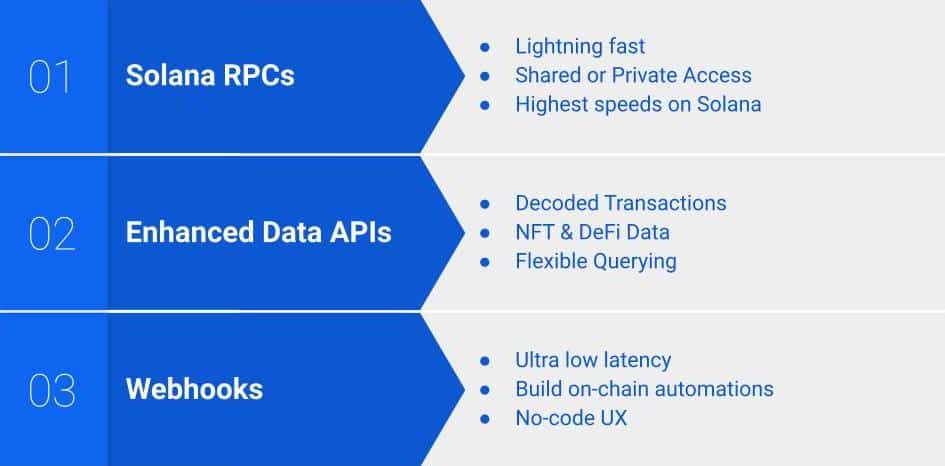
Helius started by tackling a critical data problem for Solana builders – it’s really difficult to make sense of Solana’s on-chain data. We’ve dealt with this problem first-hand at Reciprocal when using various DeFi protocols. If you go to a Solana blockchain explorer or look at the data in your wallet, it’s nearly impossible to understand what’s happening with your various transactions, accounts, and assets. Helius solves this!

This begins with Helius’ Enhanced Data APIs, which generate enriched human-readable data feeds for accounts, transactions, and assets. Helius also offers access to specialized APIs that are tailored to specific use cases for on-chain data, like NFT-related activities, NFT metadata, or NFT collection data as a few examples.
As Helius brought their Data APIs to market, many of their earliest customers were either complaining about the performance of their existing RPC provider, or directly asking for Helius to build an RPC service in concert with the Data APIs to boost efficiency and ease of use. Having their own superior RPC service directly integrated into the Enhanced Data APIs enables Helius to provide a more complete enterprise infrastructure platform with a higher quality of service overall.
The third Helius product offering is their Webhooks API, which allows you to listen to on-chain events and trigger actions when those events occur.
With Helius’ Webhooks, you don’t need to set up and maintain expensive infrastructure to keep up with the latest transactions on-chain. Helius has gone several steps further than providing basic webhooks by creating pre-configured event types and a no-code user interface. Helius’ Webhooks allow you to utilize a number of pre-configured event types like NFT sales, NFT listings, DeFi swaps, DAO votes, NFT mints, balance changes, and more. Helius’ Webhooks make it really easy to build various types of automation triggered by on-chain data, such as bots, monitoring & alerting systems, event-driven indexing, notifications & activity tracking, event logs & analytics, and workflow automation.
Solana’s Developer Rennaissance
One of the core reasons we’re so excited about Helius is that they are building the most performant infrastructure possible from the ground up, specifically for the demands of the Solana ecosystem. We believe Solana will continue to take market share from competing smart contract platforms and has the capacity to serve millions of developers and billions of users.
When assessing the various smart contract platforms in the market today one must reflect on the “Smart Contract Platform Flywheel” illustrated earlier in this post. Which combination of technology, strategy, and ability to execute will yield the most effective flywheel? Step one in the flywheel is evangelizing developers, which is where Solana has set itself apart from the competition over the last two years.
Solana has built what we believe is the best developer evangelism playbook in all of Web3. The Solana developer relations team is a well-oiled machine, producing what feels like an endless series of hackathons, hacker houses, virtual learning experiences, and in-real-life educational opportunities.
Solana has directly hosted twenty-four hacker houses and two hackathons so far in 2022, giving away more than $10 million in prizes (from Solana + sponsors) to successful projects. More than 50,000 people have participated in Solana-run hackathons and hacker houses this year, with Solana’s most recent hackathon – ‘Solana Summer Camp’ – getting 18,000 participants and 750 final project submissions to the judges.
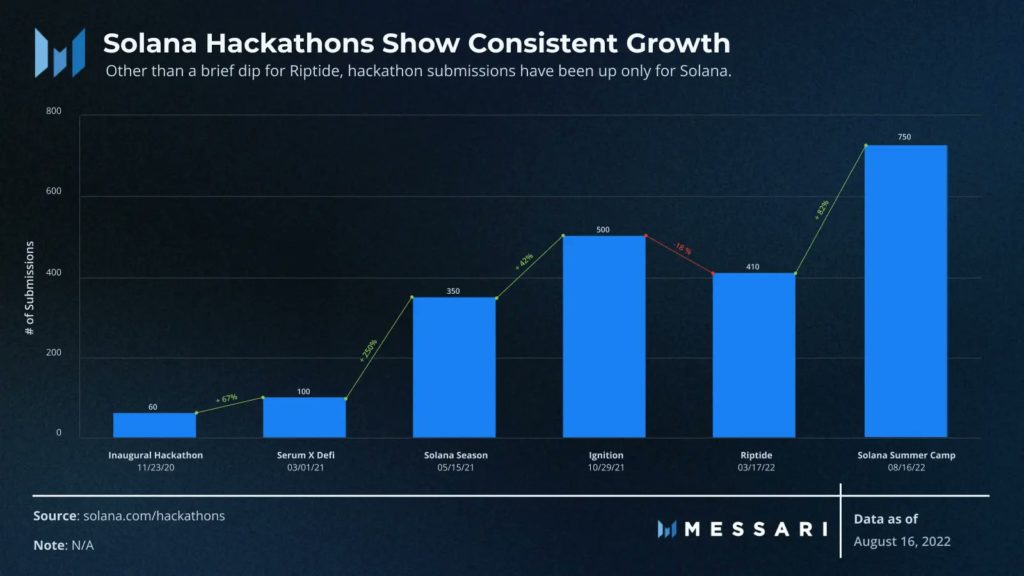
This is a powerful and sticky talent on-ramp into the Solana ecosystem, and these new developers are sticking around to build. The second and third steps in the flywheel revolve around building protocols and applications, and we’ve seen a significant number of developers choose Solana as the home of their projects. There are an estimated 100,000 developers and builders currently in the Solana ecosystem contributing to more than 17,000 active developer repositories. Additionally, the number of daily active programs used on Solana continues to rise through the bear market.
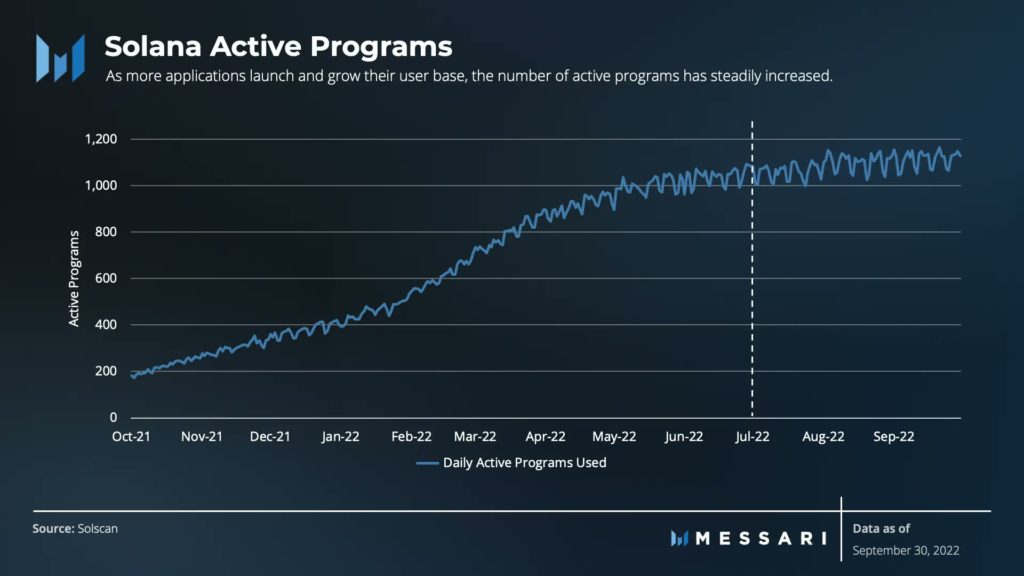
There are close to 1,200 daily active programs on Solana right now, with approximately 200,000 daily active fee-payers (consumers/users) using those programs. These numbers are nothing to scoff at, especially since the former metric has grown by more than 500% since this time last year. But we’re here for mass adoption. There are 30 million software developers and 8 billion people in the world – Meta alone has 3.7 billion monthly active users! For this level of adoption to be possible, we’re going to have to make it super easy for developers to build on Solana.
The Helius platform is a giant step in the right direction, but we still have a long way to go for developer tooling and enablement to reach parity with Web2. No code development, hybrid data, developer productivity, program testing, deployment, auditing, monitoring, and security are all bottlenecks today. These categories are of particular interest to us, and we plan to continue deploying capital behind this thesis at the Seed and Series A stages. If you’re working on something that you think would be a good fit, please don’t hesitate to reach out to our team.
Tweet
Craig Burel
Partner
Over the last four years, Craig has helped Reciprocal become a leading investor in the cryptocurrency sector, investing in some of the most successful projects in the space like Solana and The Graph. As part of Reciprocal’s interest in Digital Finance, Craig is actively investing in the Web3, Decentralized Finance, NFT, and Metaverse sectors.
Prior to joining Reciprocal, Craig was one of the first business hires at FiscalNote, an AI RegTech company, in 2014. At FiscalNote, Craig was responsible for revenue growth and go-to-market strategy as the Head of Revenue Operations & Strategy. Prior to FiscalNote, Craig worked at Morgan Stanley in their Institutional Equity Division as a Jr. Sector Specialist, focusing on the Media & Telecom space.
Craig received a B.A. in Economics from Lafayette College.
When he’s not experimenting with new money legos and minting obscure NFTs, Craig can be found on the golf course or searching for great surfing locales.
